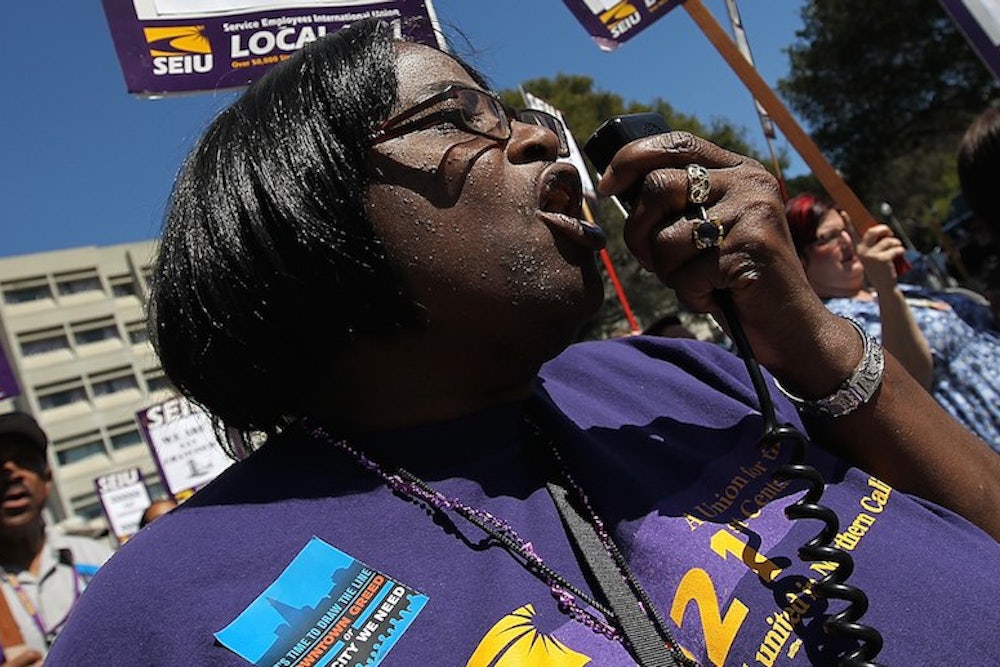The Supreme Court on Monday issued a wide-ranging opinion that will heavily impact the future of labor in America. The majority opinion in Harris v. Quinn held that home healthcare workers in Illinois and every other state that has a similar program are only “partial” or “quasi” public employees—as opposed to “full-fledged public employees”—and thus don't have to pay fees for labor representation. While the majority, led by Justice Samuel Alito, did not go so far as to fully gut the ability of public sector unions to finance their existence, the decision in the case was by no means a moderate one. Harris v. Quinn has set the stage for the eventual overruling of Abood; it has confused and perverted the concept of free-riders; and it has created an impossible standard for unions to meet.
Monday's 5-4 ruling goes against decades of Supreme Court precedent allowing fair-share provisions, starting with the seminal case of Abood v. Detroit Board of Education in 1977. (Fair share provisions require workers who choose not to join the union to pay a portion of the dues that is spent in representing them, thereby not allowing them to become free-riders.) The majority’s treatment of the balance created by Abood is problematic on several grounds. On the one hand, the opinion repeatedly states that Abood is a poorly reasoned decision which “failed to appreciate” several core issues before it, and “fundamentally misunderstood” previous Supreme Court precedent. It casts Abood as shortsighted, as it “does not seem to have anticipated the magnitude of the practical administrative problems” it created, and “did not foresee the practical problems that would face objecting members.” (On this point, the majority highlights the extreme costs associated with litigating such objections, however I would challenge the Court to point to any instance where a conservative group has not footed the bill for those who choose not to join the union.) The majority states that “a critical pillar of the Abood Court’s analysis rests on an unsupported empirical assumption,” and then accepts the premise that Abood rests on “questionable foundations.”
Despite running Abood through the ringer, the Court insists on following it closely and rebukes Illinois for trying to expand its carefully tailored holding. Though the majority stopped short of overruling Abood here, it has opened the door to future challenges; and it is hard to see how the language of this decision will not be damning to it.
Perhaps even more troubling than the majority’s attacks on significant Supreme Court precedent, upon which thousands of union contracts are based, is the majority’s flipping of the free-rider issue on its head. Under the current framework, unions are required to represent all employees in the bargaining unit, and can negotiate fair share provisions that require nonmembers to pay for the benefits that flow from that representation. No less a friend to labor than Justice Antonin Scalia defended this arrangement in a partial concurrence in a 1991 case, stating:
Where the state imposes upon the union a duty to deliver services, it may permit the union to demand reimbursement for them; or, looked at from the other end, where the state creates in the nonmember a legal entitlement from the union, it may compel them to pay the cost.
In Harris, the majority implied that it was not the objecting employees that were the true free-riders, but rather the union. The decision focused on the fact that hourly rates were set by Illinois law and there were significant statutory restrictions over what the union could bargain over. It highlighted the fact that the union received dues for its representation, but questioned what negotiations or grievance representation the union could deliver to employees.
In effect, this analysis places unions in a bind: any reasonable observer would conclude that the union negotiated with the state to set the terms of compensation, benefits, and other terms of employment, which are then codified into law. However, because the Supreme Court has demarcated this activity to the realm of lobbying, which is beyond the strict scope of representation, it concluded that the union is in effect collecting dues for doing little. The majority has drawn an untenable distinction and then complains that the distinction is not tenable.
Toward the end of its peculiar analysis, the majority articulates a new and dangerous standard or test, which surely will open the doors to future problems. “The agency-fee [or fair share] provision cannot be sustained unless the cited benefits for personal assistants could not have been achieved if the union had been required to depend for funding on the dues paid by those personal assistants who chose to join.” In effect, the Court is requiring unions to prove a counterfactual, that the workers could not have achieved the same benefits it received from the union through any other means. The Court concludes that “no such showing has been made.” However, it is not clear how anyone could make such a showing. Justice Elena Kagan, writing for herself and three other dissenting justices, proclaimed that the good news with this case is that the majority did not overturn Abood. However, if the majority’s new test is a prerequisite for fair-share agreements, it may have done irreparable damage to the balance created by Abood.
